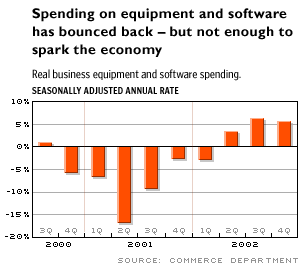NEW YORK (CNN/Money) -
Many economists hope a need to replace outdated equipment and technology will spur a business-spending spree -- the powerful medicine the ailing U.S. economy needs -- any minute now. But there are few signs that such a binge is on the way.
By some lights, it should have happened already. According to the laws of the technology-replacement cycle -- which used to hold that technology needed to be upgraded every three years, approximately -- businesses should have long ago replaced all the equipment they bought in the late 1990s to protect themselves from would-be disasters such as the euro conversion and Y2K.

But, for the most part, they haven't -- or at least they haven't done it all at once -- either because they've been able to milk maximum use out of those turn-of-the-century computers or because belt-tightening measures simply haven't allowed the extravagance of an upgrade, or both.
"Firms have cut back on their capital spending budgets to the point where some of them are not even replacing worn-out equipment," said Lehman Brothers chief economist Ethan Harris. "It's been quite a dramatic pullback, and in some sense there's some pent-up demand out there for capital equipment."
If that demand were to be suddenly turned into a spending frenzy, it would certainly give a boost to an economy that's struggled to recover from a recession that began in March 2001 and likely ended later that year.
Gross domestic product (GDP), the broadest measure of the economy's strength, grew a paltry 2.4 percent in 2002, compared with an average rate of 4.95 percent in every full calendar year of growth following recessions since 1955.
Consumer spending, which makes up more than two-thirds of the total economy, has kept the recovery afloat, driven by interest rates at 40-year lows.
But that steady spending means consumers aren't exactly sitting on a ton of cash that they're just itching to get out and spend, especially with a labor market that's not producing jobs -- private, non-farm payrolls are 2.6 million jobs trimmer than they were in March 2001.
"Consumer demand has been tapped out, so we won't see a major thrust there," said Sung Won Sohn, chief economist at Wells Fargo & Co. "We're really counting on this replacement demand, especially in the high-tech area."
Some replacement's already happened
Some replacement spending is inevitable -- equipment breaks down, and holding production steady with fewer workers sometimes forces companies to upgrade equipment.
Certainly, some of that spending has shown up in the numbers. Following a six-quarter slump that began in the fourth quarter of 2000, business spending on equipment and software increased in the last three quarters of 2002, according to the Commerce Department.
| Related stories
|

|
|
|
|
"While it's true that capacity use rates are very low, it's also true that much of that capacity has been rendered obsolete by technological advances and that replacement of capital is faster than it used to be," said David Resler, chief economist at Nomura Securities. "So a lot of businesses may feel they have little choice but to spend, if they want to preserve their competitive edge."
But with tight profit margins, terror attacks, corporate governance scandals and war keeping companies on edge, the conditions have been all wrong for the kind of en-masse tech replacement needed to make an impact on the economy.
Instead, companies have been making upgrades when they can get away with them, a trend that seems likely to continue this year. Two high-profile high-tech companies, Intel Corp. (INTC: Research, Estimates) and Microsoft Corp. (MSFT: Research, Estimates), expressed pessimism last week about the prospect of any kind of a spending boom anytime soon.
The rest of corporate America seems to agree. The Business Roundtable, an association of U.S. CEOs, found in its latest economic outlook survey that just 18 percent of 120 U.S. companies surveyed expected to spend more on capital improvements in the next six months, while 82 percent expect spending to be flat or falling.
"The outlook for capital expenditures remains very pessimistic," Business Roundtable Chairman and International Paper Co. (IP: Research, Estimates) CEO John Dillon wrote when the survey was released.
In other words, businesses might keep spending enough to keep up with the Joneses, but they certainly don't plan to spend enough to make the economy grow faster.
And therein lies a sort of Catch-22 -- the economy won't improve until businesses start spending again, but businesses won't start spending again until they're optimistic about the economy.
"As you look down the road, at some point you've got to believe there's a real recovery in capital spending on the way," said Harris of Lehman Brothers. "But I don't see the catalyst anywhere in sight."

|

